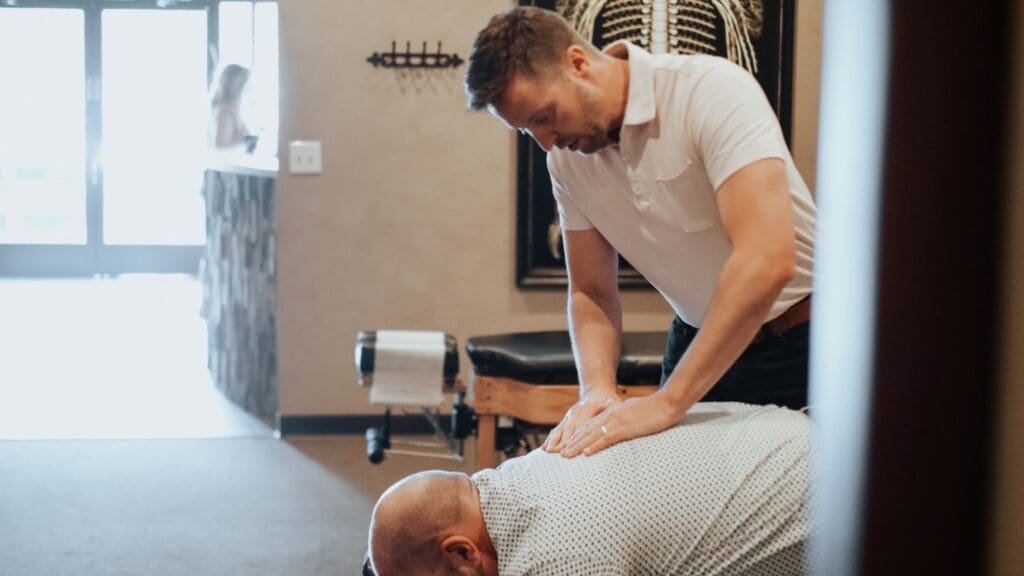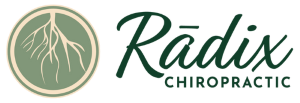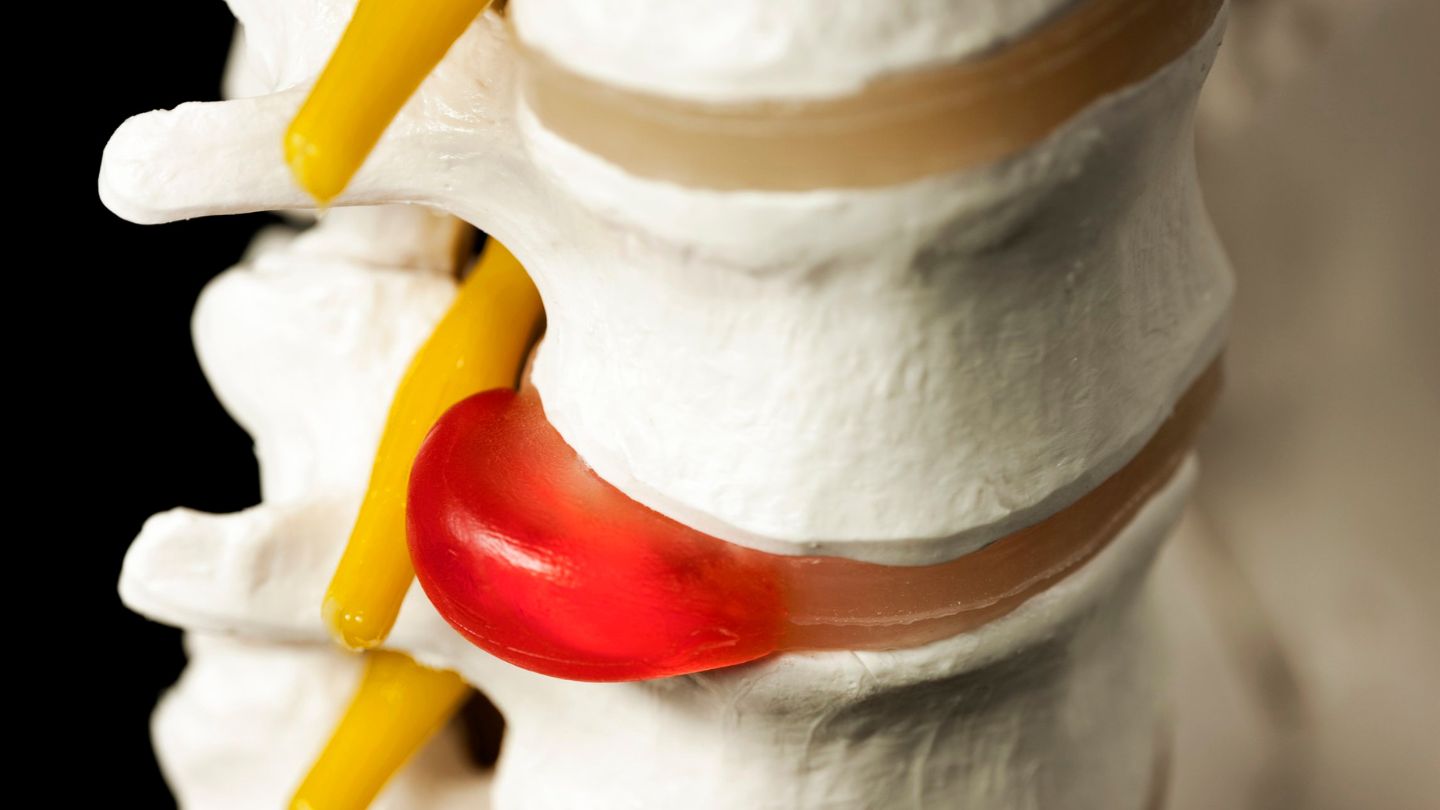Dealing with back pain from a bulging or herniated disc can be painful and frustrating, often causing symptoms such as pain and numbness that radiate throughout the body due to nerve pressure. This leads many to seek effective, non-surgical treatment options. Chiropractic care is often considered a potential solution for disc protrusion and bulging discs, but can a chiropractor actually help with a bulging disc? In this guide, we’ll explore the role of chiropractic care in treating spinal disc issues, discuss the best treatment options available, and explain what to expect on your path to recovery.
Key Takeaways
- A herniated or bulging disc involves an outward extension or rupture that can cause pain, weakness, numbness, or even chronic pain due to nerve compression along the spinal cord.
- Chiropractors use non-surgical techniques like spinal adjustments, spinal decompression, and flexion-distraction therapy to alleviate symptoms and support spinal health.
- A comprehensive treatment approach may involve collaboration with other medical professionals for optimal results, including massage therapy or physical therapy, to strengthen muscles and enhance pain relief.
Bulging Disc Pain Relief
A bulging disc occurs when a spinal disc extends outward from its normal position without rupturing, while a herniated disc involves a rupture of the outer layer that causes the soft inner material, or nucleus pulposus, to press against nearby nerves. Both conditions may cause significant discomfort and sometimes even severe pain, although herniated discs are generally more severe. Bulging discs are often linked to degenerative disc disease, where spinal discs lose their integrity over time. If left untreated, a bulging disc can progress to a more severe condition known as a slipped disc, where the disc material moves out of place, often causing intense pain.
Common Symptoms of a Bulging Disc
Symptoms of a bulging disc often include:
- Pain: Particularly in the back or neck, which varies in severity and may radiate due to nerve root compression.
- Weakness, numbness, or tingling: These sensations can affect daily activities and productivity.
These symptoms can lead to activity limitations, muscle spasms, and missed workdays. Recognizing these common symptoms is essential for setting realistic expectations for recovery and choosing the right treatment plan.
Understanding the Difference Between Disc Problems

Distinguishing between a bulging disc and a herniated disc is crucial for effective treatment. A bulging disc occurs when the soft cartilage disc between the vertebrae bulges outward, creating pressure on surrounding nerves. In contrast, a herniated disc involves the rupture of the disc’s outer layer, causing the soft inner material to compress nearby nerves.
Both conditions can exert pressure on the spinal column and other spinal structures, leading to various symptoms throughout the body. Chiropractic care is effective for both conditions, helping to relieve pressure on spinal nerves and promote healing. Knowing these differences is essential for managing symptoms and optimizing spinal health.
Techniques Chiropractors Use for Bulging Discs
To address pain from bulging or herniated discs, chiropractors employ a variety of gentle, non-invasive methods and manual therapy techniques. Here are some primary techniques used to relieve bulging disc pain:
- Flexion-Distraction Technique: This technique uses a specialized traction table to gently stretch the spine, creating negative pressure within the affected disc to relieve nerve pressure and alleviate discomfort. Flexion distraction not only addresses pain relief but also promotes spinal flexibility and supports healing within spinal discs.
- Pelvic Blocking Technique: Pelvic blocking involves placing cushioned wedges beneath the pelvis to realign the spine and relieve pressure on affected nerves. This technique often combines with therapeutic exercises to strengthen spinal muscles, helping improve alignment and provide lasting benefits.
- Spinal Manipulation: Chiropractors often use spinal manipulation, or spinal adjustments, to alleviate nerve pressure and improve spinal health. This treatment targets misaligned vertebrae, reduces joint restrictions, and supports improved spinal structures and muscle strength.
At Radix Chiropractic in Colorado Springs, we specialize in these gentle, targeted techniques to provide pain relief and support spinal health. Whether you’re dealing with bulging or herniated discs, our experienced team uses individualized treatment plans to help address pain and restore function without surgery or medications. By focusing on your unique needs, Radix Chiropractic can guide you toward lasting relief and a healthier spine.
Safety and Effectiveness of Chiropractic Care for Spinal Disc Issues

Chiropractic care is a safe, non-surgical treatment for spinal disc issues and is commonly recommended for patients with bulging or herniated discs. By using gentle, targeted techniques, chiropractors alleviate joint restrictions and nerve compression, helping reposition the disc to relieve pressure.
A major benefit of chiropractic care is its drug-free approach to pain relief, which helps patients avoid medications with potential side effects or the risks associated with surgical interventions. Chiropractic treatment can be as effective as surgery for certain disc herniation cases, providing a valuable alternative for many. In cases where additional support is needed, physical therapy can complement chiropractic care by improving muscle strength and enhancing recovery.
Begin Your Wellness Journey
At Radix Chiropractic, we’re committed to providing gentle, non-surgical options to relieve pain and improve the quality of life for those struggling with bulging or herniated discs. Our family chiropractic in Colorado Springs focuses on individualized, holistic treatment plans that address the root cause of your discomfort without the need for medication or surgery. Schedule your appointment today and take the first step towards comprehensive wellness with Radix Chiropractic. Your path to improved well-being starts here!
FAQs
Can chiropractic adjustments make a bulging disc worse?
No, chiropractic adjustments are designed to relieve disc pressure and support healing. Chiropractors use specific, non-invasive techniques that are tailored to avoid aggravating disc conditions and provide safe, effective relief.
How many chiropractic sessions are typically needed for a bulging disc?
The number of sessions depends on the severity of the disc issue and individual factors like age and lifestyle. Patients may notice improvement within a few weeks, though some may need a longer treatment plan to address pain fully and improve spinal disc health.
Is spinal decompression safe for treating a bulging disc?
Yes, spinal decompression is a safe and widely recommended therapy for bulging discs and related disc pain. By creating negative pressure within the disc, it helps alleviate nerve compression without invasive surgery.
Can chiropractic care help prevent future disc problems?
Yes, chiropractic care supports ongoing spinal health, which can help prevent future issues with bulging or herniated discs. Chiropractors can also provide lifestyle guidance, including exercises and posture tips, to support spinal wellness.
What lifestyle changes can support recovery from a bulging disc?
Supporting recovery involves regular, moderate exercise, maintaining good posture, and using ergonomic furniture. Avoiding heavy lifting, sudden movements, and poor posture can help reduce strain on the spine and prevent further issues.

